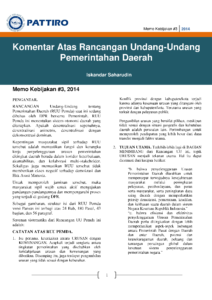 Decentralization in Indonesia began on May 7, 1999. The decentralization referred to here is the conception and practice of decentralization in accordance with the Reform Agenda: implementing regional autonomy as wide as possible. This decentralization milestone was marked by the issuance of Law Number 22 of 1999 concerning Regional Government.
Decentralization in Indonesia began on May 7, 1999. The decentralization referred to here is the conception and practice of decentralization in accordance with the Reform Agenda: implementing regional autonomy as wide as possible. This decentralization milestone was marked by the issuance of Law Number 22 of 1999 concerning Regional Government.
Since then, the Regional Government Law has been revised and amended several times. At this moment, at the end of President SBY's term, the Regional Government Law will be amended again. It has even been decided to split into three bills. The three bills are the Bill on Regional Government itself, the Bill on Regional Head Elections, and finally the Bill on Village Governance. The last bill was enacted into law in early 2014, under the name of Law Number 6 of 2014 concerning Villages.
The Draft Law on Regional Government (RUU Pemda) is currently being discussed by the DPR and the Government. This regional government bill determines the regional autonomy system that is implemented. Is it fully decentralized, asymmetrical decentralized, decentralized with dominant deconcentration.
Civil society's interest in the bill is to ensure that the functions and framework for implementing government affairs at the regional level are in the corridor of openness, accountability and multi-stakeholder collaboration. At the same time, it also ensures that the bill does not give negative excesses to democracy and human rights. In order to obtain this guarantee, civil society is obliged to actively present its views and influence the processes that take place in the DPR building.
As an illustration, the content structure of the Special Committee's version of the Regional Government Bill is divided into 24 chapters, 180 articles, 43 sections and 56 paragraphs.
